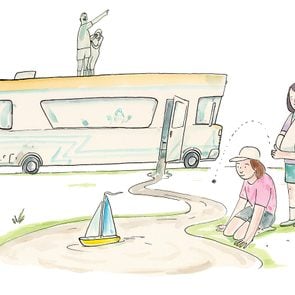Why Tipping Etiquette Makes Absolutely No Sense

Figuring out how much to leave for service rendered is more confusing than ever—and it’s even worse if you’re travelling. Help!
I recently attended a wedding in rural Quebec, and guests were provided with a car and driver for the 90-minute journey into the hills. That was exciting: A private car! I could pretend I was rich! Since I’m not, though, I had no idea how much this trip actually cost. As a result, when our driver picked us back up at midnight, I secretly fretted all the way home about tipping him.
I fished around nervously in my purse and realized that all I had was a $100 note, which I was keeping for an emergency. I had nothing smaller.
Ack! I couldn’t not tip him, and I had nothing else to offer but two chocolates from the wedding. So, I could tip high—or spectacularly low. I defaulted to high and surrendered the money as my two kids and I clambered out. I was, I confess, too tipsy to think through the idea of asking for change.
In my defence, I wouldn’t have known the math, anyway. The whole matter of tipping has long been a source of awkward interactions—and, for some travellers, mild anxiety—throughout the world. Tipping etiquette varies wildly from country to country. A friend in Rome tells me that Italians get offended by excessive gratuities. “Leaving a big tip is considered vulgar,” she insists. “I’ve had Italian friends make me take money back.”
Uh-oh. Our driver had said he was half-Greek and half-Lebanese. If for some reason the Italian attitude applied to Greeks or Lebanese, my big tip might have left him offended and me missing my emergency cash.
When people take with them their own expectations about tipping etiquette as they roam the world, it generates no small amount of confusion. Norwegians, who come from a culture where wages are high and tips are low, could burn through Las Vegas leaving a trail of outrage with their tiny offerings.
Meanwhile, notoriously high-tipping Americans might insult everyone in Tokyo because good service in Japan is a matter of honour, as in: “How dare you suggest I be rewarded for handing you a plate of sashimi without dropping it in your lap?”
We’re all in an embarrassed mess because there’s no consistent logic to any of this. None!
Tipping began, as far as we know, in Tudor England, with aristocrats swanning about one another’s country homes, paying the servants extra for helping them put on their ruffs. Hundreds of years later, tipping etiquette has become totally arbitrary. A 2016 study from Cornell University, published in the Journal of Economic Psychology, found that people are twice as likely to tip a grocery delivery person than a grocery store clerk, and roughly twice as likely to tip a waiter than a fast-food restaurant worker.
Why is that? A paid job is a paid job, right? The grocery deliverer is paid to deliver and the grocery clerk is paid to clerk. So tipping one and not the other only makes sense in terms of what has become customary.
More examples from the study: Party clowns get tipped more often than dental hygienists—even though the latter bravely confront the malodorous insides of our mouths. Limousine drivers get rewarded more often than fishing guides. And nobody can work out the reasons for these differences; don’t fishing guides go the extra mile, too?
All this is compounded by a phenomenon called “tip creep,” which coincides with the proliferation of portable pay machines that feature automatic tip prompts. They have moved beyond restaurant settings to places like car-repair shops, causing people to feel guilty if they hit the “no tip” option. I recently went to a card-only bakery and their debit machine had tip prompts—for selling me a donut. I tipped 15 percent.
Good luck with any consistency if you’re tipping in Europe. Research across seven European countries in 2020 found that Germans and Swedes are more likely to tip in restaurants than the Spanish or Swiss, while only 40 percent of French consumers offer a gratuity. Norwegians are the least likely to tip: fewer than 15 percent leave a little extra on the table. As for the size of the tip, it’s lowest in France and Norway (less than two percent of the bill), and highest in Germany (7.5 percent) and Sweden (nine percent).
“From a service worker’s viewpoint,” lead study author Stefan Gössling of Sweden’s Lund University notes, “the most desirable tipping culture is probably in Germany, where minimum wages are high, tipping is a norm and tip percentages are high and mostly paid in cash.” In Spain, by contrast, “the situation for service workers is the least favourable; the minimum wage is low, as are tip percentages.”
Compare that to the United States, where restaurant tips of up to 25 percent are now expected for very good service; in Canada, it’s 15 to 20 percent. Why? Because the restaurants pass along wage standards to consumers. It’s the diners’ job to make sure servers can pay their rent.
No one expects a tip in much of Southeast Asia (for example, Thailand or Vietnam) or Australia, beyond saying “keep the change.” In Taiwan and Hong Kong, a 10 percent gratuity is added at most restaurants. Sometimes, that too can feel nerve-wracking. “Even when the server tells you about it up front, it’s awkward,” one friend who encountered this custom said. “Do you tip more if they were really good? What if they weren’t good?”
It’s enough to make your head hurt, and that’s just fretting about cash—will we soon have to worry about tipping with bitcoin? I don’t even understand the notion of cryptocurrency, much less how to use the new tipping apps that are popping up around it.
Maybe that’s how people used to feel about money itself, back when they traded goods and services with shells and weapons and sacks of rice. Back when there was no tipping.
Still sweating over tipping etiquette? Don’t worry—everyone’s entitled to their share of travel mistakes.






